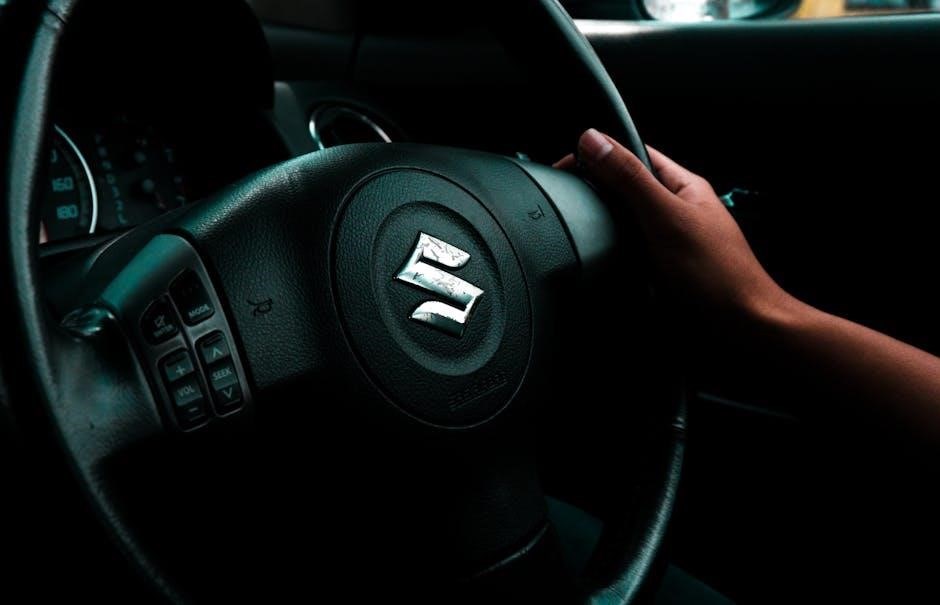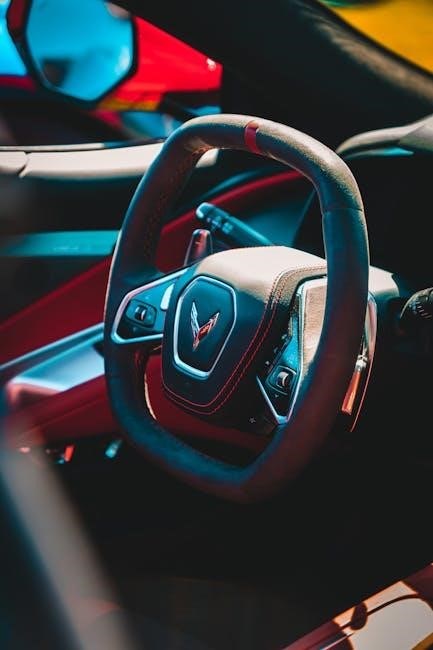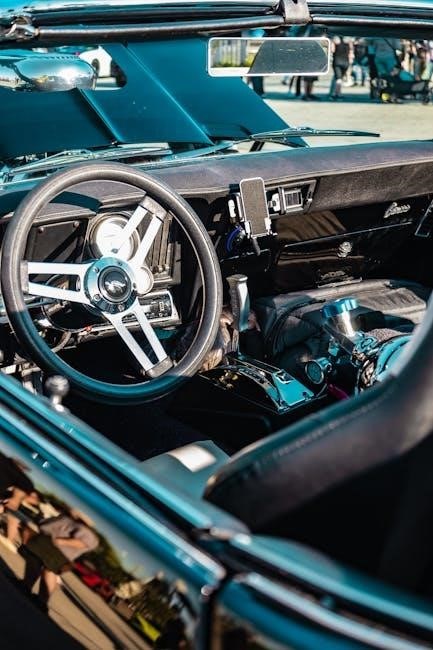Manual transmissions offer precise control over gear shifts, enhancing driving engagement. The debate between 5-speed and 6-speed manuals focuses on gear ratios, fuel efficiency, and performance, catering to different driving needs and vehicle types.
1.1 What Are Manual Transmissions?
Manual transmissions, also known as stick shifts, require the driver to manually change gears using a clutch pedal and gearshift. Each gear ratio provides specific power and speed outputs, with lower gears for more power and higher gears for speed. The clutch temporarily disconnects engine power during shifts, allowing smooth transitions. Manual transmissions are known for their fuel efficiency, cost-effectiveness, and driver engagement. They rely on synchronizers to align gear speeds, ensuring smoother shifting. While modern variants like 5-speed and 6-speed manuals differ in gear ratios and applications, they share the same fundamental operation and benefits for drivers seeking control and performance.
1.2 Evolution of Manual Transmissions

Manual transmissions have evolved significantly, from early 3-speed systems to modern 5-speed and 6-speed designs. The addition of each gear allowed for better optimization of engine power and fuel efficiency. Early manuals often lacked synchronizers, requiring double-clutching, while modern versions feature refined mechanisms for smoother shifting. The shift from 5-speed to 6-speed manuals introduced closer gear ratios, reducing engine strain at higher speeds and improving performance. These advancements reflect ongoing innovation to meet changing driver demands, vehicle applications, and technological progress, ensuring manual transmissions remain relevant in an increasingly automatic world.

Understanding 5-Speed Manual Transmissions
A 5-speed manual transmission offers a balance of simplicity and versatility, with five forward gears designed to optimize engine performance and fuel efficiency for various driving conditions.
2.1 History and Development
The 5-speed manual transmission emerged in the 1980s as a refinement over earlier 3- and 4-speed designs. It offered improved fuel efficiency and smoother shifting, becoming a standard in many vehicles. The addition of a fifth gear allowed for better spacing between ratios, enhancing both city and highway driving. Its simplicity and reliability made it a favorite among drivers. While 6-speed manuals have since gained popularity, the 5-speed remains a practical choice for lighter vehicles and urban driving scenarios, emphasizing a balance between performance and ease of use.
2.2 Key Features and Design
The 5-speed manual transmission is designed for simplicity and durability, featuring a compact gearbox with five forward gears and one reverse. Its lightweight construction makes it ideal for smaller vehicles, reducing overall weight and improving fuel efficiency. The gear ratios are spaced to optimize acceleration in lower gears, while higher gears provide adequate cruising speeds. Synchronizers ensure smooth shifting between gears, minimizing wear and tear. The design emphasizes reliability and ease of maintenance, making it a cost-effective option for drivers prioritizing functionality over high performance.
2.3 Advantages of 5-Speed Manuals
5-speed manual transmissions are praised for their simplicity, reliability, and affordability. They are lighter and more compact, making them ideal for smaller vehicles. With fewer components, they are less complex to maintain and repair, reducing long-term costs. The wider gear spacing in 5-speeds often results in better low-end torque, which is beneficial for city driving and hauling heavier loads. Additionally, the straightforward design contributes to improved fuel efficiency in urban environments. For drivers seeking a no-frills, budget-friendly option with ample performance for everyday use, the 5-speed manual remains a practical and dependable choice.
2.4 Common Applications
5-speed manuals are commonly found in lightweight, compact vehicles and city cars where simplicity and efficiency are prioritized. They are popular in budget-friendly models, such as hatchbacks and entry-level sedans, due to their lower production and maintenance costs. Additionally, classic and retro cars often feature 5-speed transmissions, appealing to enthusiasts who value traditional driving experiences. These transmissions are also used in work vehicles and smaller trucks where durability and straightforward operation are essential. Their widespread adoption in urban and regional markets highlights their versatility and suitability for everyday driving scenarios.

Understanding 6-Speed Manual Transmissions
6-speed manual transmissions offer improved performance and fuel efficiency through closer gear ratios, allowing engines to operate at optimal RPMs during acceleration and cruising.
3.1 History and Development
The 6-speed manual transmission emerged in the early 1990s, with the T-56 model debuting in the 1992 Dodge Viper. Designed by BorgWarner, it featured a robust design and closer gear ratios, enhancing performance and fuel efficiency. Initially used in high-performance vehicles, it gained popularity across various car models. The T-56 became a benchmark for modern manuals, offering smoother shifting and better adaptability to diverse driving conditions compared to 5-speed counterparts.
3.2 Key Features and Design
The 6-speed manual transmission features a compact design with six forward gears, offering improved gear ratios for enhanced performance and efficiency. It includes advanced synchronizers for smoother shifting and often incorporates a reverse gear. The T-56 model, for instance, uses one-piece forgings for durability. Modern designs focus on weight reduction and noise minimization, making them suitable for both high-performance and everyday vehicles. The additional gear allows for better torque management and fuel economy, especially at higher speeds, compared to 5-speed models.
3.3 Advantages of 6-Speed Manuals
6-speed manual transmissions provide improved performance and fuel efficiency due to closer gear ratios, enabling smoother power delivery and better torque management. They reduce engine strain at high speeds, enhancing comfort during long drives. The additional gear allows for optimized RPM levels, improving both acceleration and mileage. This makes them ideal for high-performance vehicles and highway driving. Modern designs often feature advanced synchronizers for quicker shifts. Overall, 6-speed manuals strike a balance between driving engagement and practicality, offering superior versatility compared to 5-speed counterparts.
3.4 Common Applications
6-speed manual transmissions are commonly found in high-performance sports cars, modern hatchbacks, and SUVs. They are favored in vehicles requiring precise control and optimal gear ratios for both city and highway driving. Additionally, they are often paired with advanced engines, such as turbocharged or diesel units, to maximize efficiency and power delivery. Luxury and performance-oriented vehicles benefit from the smooth shifting and reduced engine strain provided by the extra gear. This makes 6-speed manuals a popular choice for drivers seeking a blend of performance, comfort, and fuel efficiency in a wide range of vehicle applications.

Comparison of 5-Speed and 6-Speed Manuals
6-speed manuals offer an extra gear for better fuel efficiency and smoother highway driving, while 5-speeds are lighter and simpler, often used in smaller, city-focused vehicles.
4.1 Fuel Efficiency and Performance
6-speed manual transmissions generally offer better fuel efficiency due to tighter gear ratios and an additional overdrive gear, reducing engine RPM at higher speeds. This leads to improved performance in highway driving. In contrast, 5-speed manuals often have wider spaced gears, which can result in lower fuel economy, especially on long trips. However, 5-speeds may provide better low-end torque for city driving, making them suitable for lightweight vehicles. The choice between the two depends on driving habits and priorities—whether it’s optimizing fuel efficiency or maximizing urban performance.
4.2 Gear Ratios and Driving Experience
6-speed manual transmissions typically feature closer gear ratios, providing smoother acceleration and better control during high-performance driving. The additional gear allows for optimal RPM management, especially at higher speeds, enhancing fuel efficiency. In contrast, 5-speed manuals often have wider spaced ratios, which can result in larger jumps between gears. This can make shifting feel less precise, particularly in performance-oriented scenarios. However, 5-speeds may offer a simpler, more direct driving experience, making them suitable for urban environments where frequent shifting is less necessary. The choice depends on whether smooth, high-speed performance or straightforward city driving is prioritized.
4.3 Maintenance and Durability
Manual transmissions are generally durable, but 5-speeds tend to be simpler and more straightforward to maintain due to fewer components. The 6-speed, with an additional gear, introduces more parts, potentially increasing the risk of wear and tear over time. Synchronizers and bearings in 6-speeds may experience greater stress due to closer gear ratios. However, modern manufacturing has improved the reliability of both setups. Repair costs for 6-speeds can be higher due to complexity, while 5-speeds often benefit from wider parts availability and simpler mechanics, making them more accessible for DIY maintenance and repairs.
4.4 Cost Differences
Generally, 5-speed manuals are more affordable than 6-speeds due to fewer components and simpler design. The additional gear in 6-speeds increases production costs, making them pricier. Used 5-speed transmissions are often cheaper and easier to source, while 6-speeds, especially those with advanced features, can be more expensive. However, the cost difference narrows in high-performance or specialized models, where 6-speeds may offer better value through improved fuel efficiency and performance. Overall, budget-conscious buyers often opt for 5-speeds, while those prioritizing performance and modern features may prefer 6-speeds despite the higher cost.
4.5 Weight and Complexity
5-speed manual transmissions are generally lighter and less complex than 6-speeds due to fewer gears and components. The additional gear in 6-speeds adds weight and complexity, requiring more engineering to maintain smooth shifting. However, modern 6-speeds often feature optimized designs to minimize weight gain. For instance, the TREMEC Magnum 6-Speed, while heavier than its 5-speed counterparts, offers superior strength and versatility. The trade-off is noticeable in high-performance applications, where the extra gear and advanced features justify the added complexity and weight for enhanced driving dynamics and efficiency.

When to Choose a 5-Speed Manual
A 5-speed manual is ideal for lightweight and compact vehicles, urban driving, and budget-friendly options, offering simplicity and efficiency without the need for extra gears.
5.1 Lightweight and Compact Vehicles
Lightweight and compact vehicles benefit from 5-speed manuals due to their simpler design and lower weight, which enhances fuel efficiency and responsiveness in urban environments. These transmissions are well-suited for smaller engines, providing optimal performance without unnecessary complexity. The reduced number of gears allows for smoother shifts and better acceleration in tight spaces, making them ideal for city driving and budget-conscious drivers. Additionally, the compact size of 5-speed transmissions makes them easier to install and maintain in smaller vehicles, ensuring reliability and cost-effectiveness.
5.2 Urban and City Driving
5-speed manual transmissions excel in urban and city driving due to their simplicity and responsiveness. With fewer gears, they provide quick and smooth acceleration, ideal for stop-and-go traffic. The lighter weight of 5-speeds enhances fuel efficiency, reducing the strain on smaller engines common in city vehicles. Additionally, the fewer gear shifts required in urban environments make driving less fatiguing. This makes 5-speed manuals a practical choice for drivers navigating tight city streets and frequent traffic lights, offering a balance of performance and efficiency tailored to low-speed, high-traffic conditions.
5.3 Budget-Friendly Options
5-speed manual transmissions are often more affordable than their 6-speed counterparts, making them a cost-effective choice for budget-conscious buyers. With fewer components and a simpler design, they reduce production costs, which are passed on to consumers. This makes them ideal for entry-level vehicles or those seeking a reliable, no-frills driving experience. Additionally, the lower price point of 5-speeds allows car owners to allocate resources to other vehicle upgrades or maintenance, offering long-term financial benefits without compromising on essential performance and functionality.

When to Choose a 6-Speed Manual
A 6-speed manual is ideal for high-performance driving, offering closer gear ratios for better fuel efficiency and smoother shifting. It excels in high-speed cruising and hilly terrain, reducing engine strain while maintaining optimal power delivery. The additional gear provides better acceleration in lower gears and reduces frequent shifting at higher speeds, making it suitable for both city and highway driving. This makes it a preferred choice for drivers seeking enhanced control and performance without compromising on practicality.
6.1 High-Performance Vehicles
For high-performance vehicles, 6-speed manuals are preferred due to their ability to deliver smoother power delivery and quicker acceleration. With closer gear ratios, drivers can maintain optimal engine RPM during aggressive driving, enhancing both performance and control. The additional gear allows for better management of torque, especially in vehicles with high horsepower engines. This setup is common in sports cars and performance-oriented models, where precise gear control and responsive shifting are critical for maximizing speed and handling. The 6-speed manual’s design caters to the demands of high-performance driving, making it a staple in many modern sports cars and racing applications.
6.2 Long-Distance and Highway Driving
For long-distance and highway driving, 6-speed manual transmissions are advantageous due to their overdrive gear, which reduces engine RPM at high speeds, improving fuel efficiency and reducing engine wear. The additional gear allows for quieter operation and less strain on the engine during extended highway drives. This makes 6-speed manuals more comfortable for long trips, as they enable the vehicle to maintain optimal RPM levels without frequent shifting. The smoother power delivery also enhances overall driving comfort, making it ideal for cross-country journeys or commutes on open roads.
6.4 Modern and Advanced Features
Modern 6-speed manual transmissions often incorporate advanced technologies such as lighter materials, optimized gear ratios, and improved synchronizers, enhancing both performance and durability. Features like rev-matching systems and electronic clutch controls are increasingly common, providing smoother shifting and reduced driver effort. Additionally, some 6-speed manuals integrate with advanced driver-assistance systems, offering a blend of traditional driving engagement with contemporary convenience. These innovations make 6-speed manuals more appealing in today’s market, especially in high-performance and luxury vehicles, where both driving experience and technological sophistication are prioritized.

Popular Models with 5-Speed Manuals
Nissan models like the Sentra and Versa have historically featured 5-speed manuals, offering affordability and simplicity. Classic and retro cars also often retain 5-speed transmissions for their timeless appeal.
7.1 Nissan Models
Nissan has long been associated with reliable manual transmissions, and their 5-speed offerings are no exception. Models like the Sentra and Versa have historically featured 5-speed manuals, emphasizing affordability and simplicity. These transmissions are well-suited for everyday driving, providing smooth shifts and excellent fuel economy. Nissan’s 5-speed manuals are often praised for their durability and ease of maintenance, making them a popular choice for budget-conscious drivers. Additionally, the iconic Nissan 350Z also utilized a 5-speed manual, blending performance with practicality. Overall, Nissan’s 5-speed manual-equipped cars remain a favorite among enthusiasts and commuters alike.
7.2 Classic and Retro Cars
Classic and retro cars often feature 5-speed manual transmissions, offering a nostalgic driving experience. These transmissions were common in iconic models like the Nissan 350Z and Volkswagen Rabbit, providing simplicity and direct control. In contrast, 6-speed manuals started appearing in later retro-inspired cars, offering closer gear ratios and improved performance. While 5-speeds are praised for their straightforward design, 6-speeds provide a sportier feel with better fuel efficiency. Enthusiasts often prefer 5-speeds for their vintage appeal, while 6-speeds cater to those seeking modern enhancements without losing the classic charm. Both options retain the essence of manual driving, cherished by retro car aficionados.

Popular Models with 6-Speed Manuals
Models like the Ford Mustang, Chevrolet Camaro, and Mazda MX-5 often feature 6-speed manuals, offering precise control and enhanced performance for driving enthusiasts.
8.1 Sports Cars and Performance Vehicles
Sports cars like the Ford Mustang, Chevrolet Camaro, and Mazda MX-5 often feature 6-speed manual transmissions. These gearboxes offer closer ratios for better acceleration and control. The 6-speed design allows drivers to maintain optimal RPMs during spirited driving, enhancing performance. Additionally, the extra gear provides a smoother transition between shifts, reducing wear on the engine and improving fuel efficiency. For high-performance vehicles, the 6-speed manual is preferred for its precision and responsiveness, making it a staple in enthusiast-driven cars. This setup is ideal for both track and highway driving, delivering a balanced blend of power and refinement.
8.2 Modern Hatchbacks and SUVs
Modern hatchbacks and SUVs increasingly adopt 6-speed manual transmissions for enhanced fuel efficiency and smoother acceleration. Vehicles like the Honda Fit and Subaru Crosstrek feature this setup, offering better RPM management during highway driving. The additional gear allows engines to operate within optimal ranges, improving mileage and reducing strain. This configuration is particularly beneficial for smaller engines, ensuring responsiveness without compromising efficiency. As a result, 6-speed manuals have become a popular choice for everyday drivers seeking a balance between performance and practicality in modern, compact vehicles.

The Future of Manual Transmissions
Manual transmissions face declining popularity but remain relevant through innovation, offering improved gear ratios and integration with modern technology to cater to enthusiast demand for driving purity and control.
9.1 Decline in Popularity
Manual transmissions, especially 5-speeds, are becoming less common as automatic and CVT options gain favor. Modern drivers prioritize convenience and ease, particularly in urban settings, over manual shifting; The rise of SUVs and EVs, which often feature automatic transmissions, has further reduced demand for manual gearboxes. Additionally, advancements in automatic transmissions now offer similar fuel efficiency and performance to manuals, making them more appealing to a broader audience. As a result, only a few models, like the Nissan, still offer 5-speed manuals, signaling a shift toward automatic dominance in the automotive market.
9.2 Innovation and Technological Advancements
Despite declining popularity, manual transmissions continue to evolve with technological advancements. Modern 5-speed and 6-speed manuals feature optimized gear ratios, lightweight materials, and improved synchronizers for smoother shifting. Innovations like dual-mass flywheels and electronic clutch assistants enhance drivability. Some high-performance manuals incorporate advanced materials for durability and reduced weight. Additionally, the integration of overdrive gears in 6-speed transmissions improves fuel efficiency and reduces engine strain during highway driving. These advancements ensure that manual transmissions remain viable options for drivers seeking a more engaged and efficient driving experience, even as automatics dominate the market.
